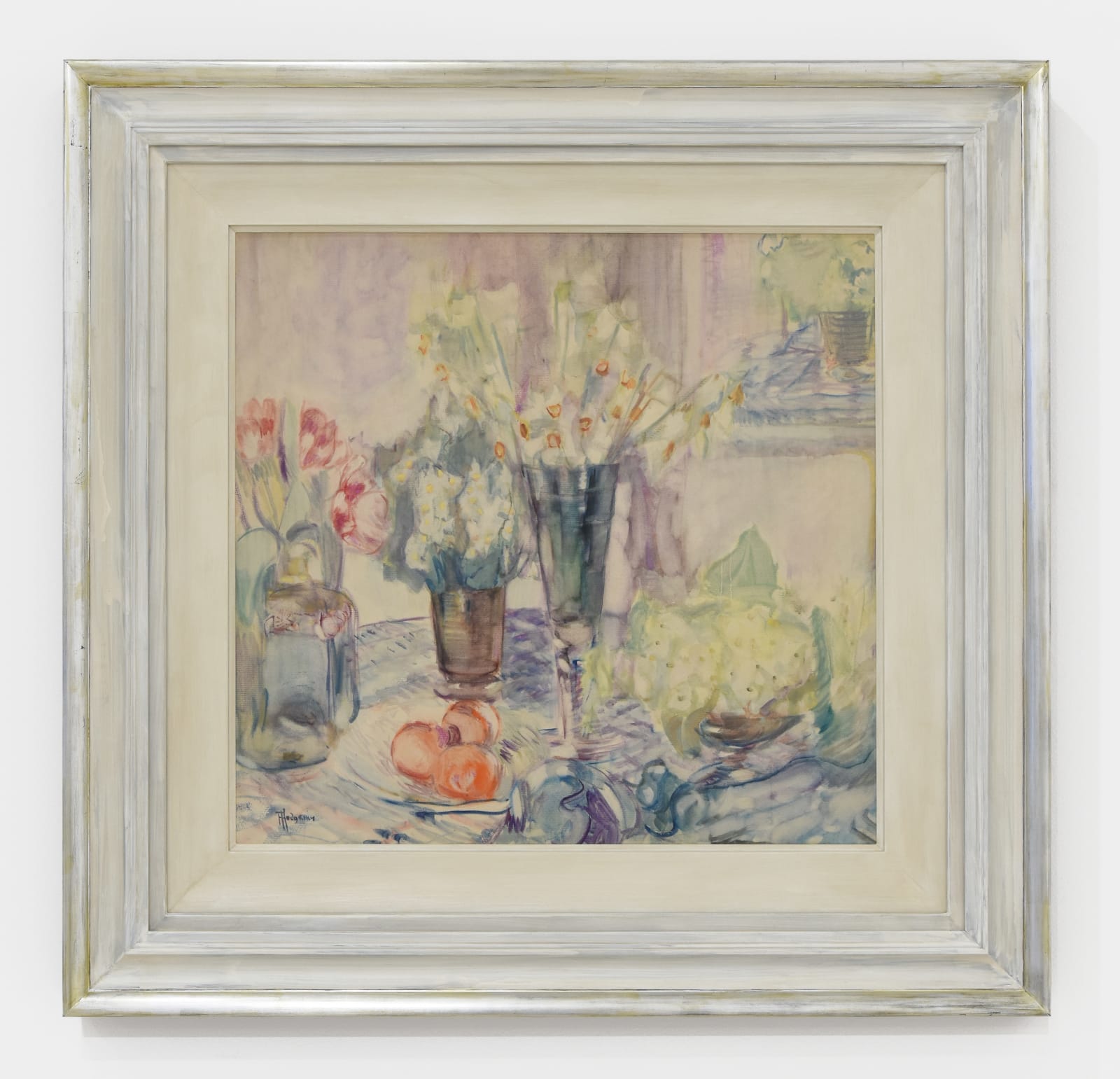



Frances Hodgkins
Spring, c. 1909
watercolour heightened with bodycolour on paper
567 x 592mm
885 x 860 x 60mm framed
885 x 860 x 60mm framed
Further images
The still life is an enduring subject matter that Hodgkins returned to throughout her career. Spring, 1929, features a softly blurred vision of a table full of fruit and flowers....
The still life is an enduring subject matter that Hodgkins returned to throughout her career. Spring, 1929, features a softly blurred vision of a table full of fruit and flowers. Rendered mainly in pastels and subdued tones, the work has a subtle visual poetry that portrays Hodgkins’ knowledge and exploration of form and colour within watercolour. She has skilfully rendered the transparency of the glass vessels, showing how the application of pigment can be as effective in its absence, as in its presence. The resulting effect is ethereal, as though light is diffused across the paper’s surface.
Spring has been attributed to the year 1929, however, recent research suggests there are several stylistic similarities to the work Rosamund from c.1909 - possibly featuring the same table and vase. The signature, similarly, matches others from this period. Thus, this still life of Spring could be from c.1910. In this instance, the work may have been from a grouping of watercolours that Hodgkins hoped to send off to Paris in 1910. Hodgkins wrote in her letters, “the fear of death was upon me in case I couldn’t get them finished, having ordered frames etc…& now they are off to frame – (& fame) I hope.”1 Hodgkins had displayed a mastery of watercolours by this period, which was the catalyst for the beginning of her teaching career—in 1909 she won the American Club prize, which offered an opportunity to have a studio to teach from. Not long after, she was asked to teach watercolour at Colarossi’s, the first woman ever to do so. After a year there, she opened her own teaching studio for only women. Teaching became pertinent to Hodgkins’ survival as an independent female artist. She always placed it as secondary to her own artistic career, however she has been known to have left a real legacy to her students.2
Spring is a prime example of Hodgkins’ ability to balance structure and spontaneity. It captures a moment of quiet intimacy while also demonstrating her bold engagement with modernist techniques. This work stands as a testament to her pivotal role in reshaping the boundaries of still life painting in the early 20th century.
1. Letters of Frances Hodgkins, ed. Linda Gill (Auckland: Auckland University Press, 1993), p. 255
2. Frances Hodgkins 1869-1947 , exhibition publication from Whitford and Hughes, London, 1990, introduction.
Spring has been attributed to the year 1929, however, recent research suggests there are several stylistic similarities to the work Rosamund from c.1909 - possibly featuring the same table and vase. The signature, similarly, matches others from this period. Thus, this still life of Spring could be from c.1910. In this instance, the work may have been from a grouping of watercolours that Hodgkins hoped to send off to Paris in 1910. Hodgkins wrote in her letters, “the fear of death was upon me in case I couldn’t get them finished, having ordered frames etc…& now they are off to frame – (& fame) I hope.”1 Hodgkins had displayed a mastery of watercolours by this period, which was the catalyst for the beginning of her teaching career—in 1909 she won the American Club prize, which offered an opportunity to have a studio to teach from. Not long after, she was asked to teach watercolour at Colarossi’s, the first woman ever to do so. After a year there, she opened her own teaching studio for only women. Teaching became pertinent to Hodgkins’ survival as an independent female artist. She always placed it as secondary to her own artistic career, however she has been known to have left a real legacy to her students.2
Spring is a prime example of Hodgkins’ ability to balance structure and spontaneity. It captures a moment of quiet intimacy while also demonstrating her bold engagement with modernist techniques. This work stands as a testament to her pivotal role in reshaping the boundaries of still life painting in the early 20th century.
1. Letters of Frances Hodgkins, ed. Linda Gill (Auckland: Auckland University Press, 1993), p. 255
2. Frances Hodgkins 1869-1947 , exhibition publication from Whitford and Hughes, London, 1990, introduction.
Provenance
Private collection, Dr J. Mories Bassett, London, EnglandExhibitions
Frances Hodgkins and Vera Cunningham, Bloomsbury Gallery, London, England, November 1929Revisiting Modernism, Gow Langsford Gallery, Auckland, New Zealand, 27 September–14 October 2023


